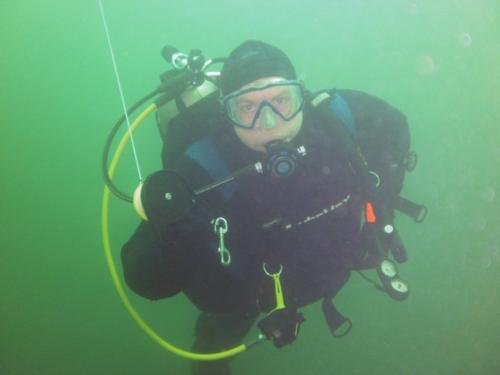
Fraser Debney didn’t get cold feet for winter diving when his alternate air source froze open in the St. Lawrence River, forcing him to abort a Boxing Day dive at Cardinal Ontario. On January 2, he was back at it in the same river, this time at Morrisburg, exploring the lost villages that were submerged during the building of the St. Lawrence Seaway almost 60 years ago.
He was down 58 minutes with six other divers, visiting the submerged Lock 23, the houses and foundations left behind on the river bottom and the old Highway 2, now covered in silt but easily identified because no seaweeds grow along its ribbon-like path.
There were no equipment problems this time. Fraser had upgraded to a more environmentally sealed
primary regulator designed for colder water temperatures than his former one. He said a lot of dive gear is designed for southern climates and while some will say it is cold-water ready, “cold to California is different than cold water in Canada.”
But the piece of equipment Fraser really was interested in testing was his dive suit. Unlike the other six divers, who wore
dry suits (preferred for cold water because of their warmth), he was wearing a
wetsuit. Beneath it, he wore a fine thermal type of underwear. It got wet, but it stayed warm in that layer between his body and the wetsuit.
Before they entered the water, a couple of his diving mates joked that he was making them feel cold, just seeing him in a wetsuit on a winter dive.
“One of the divers is a doctor and at the end of the dive he said he was absolutely amazed I did the entire dive,” said Fraser. “He was watching me under water.”
He felt cold for two or three minutes when he first got into the water but quickly got used to it. But cold water (its temperature that day was 30 degrees Fahrenheit) has the benefit of clarity. There was a lot to see.
“Some of the old locks were big ones. The railings were still there where people walked on the top of them. This one was 35 feet down but in some of the areas they were deeper, dredged out for bigger ships.”
The buildings from the old original power stations had been taken away but a lot of the machinery was still under water.
Earlier, on the Boxing Day dive, which involved four divers, two of them experienced similar freeze-up problems to Fraser’s, but not as quickly. They got to see some of the underwater sights at Cardinal. There, the attraction was the wreck of the Conestoga, a freighter carrying a cargo of wheat that burned and sank in the 1920s.
The dive site was chosen for its “large safety factor” (shallow water and the current is not strong). This is why the Conestoga wreck is the location of many training dives.
Now that he has determined his equipment can withstand cold water temperatures, Fraser may expand his winter diving experiences even further. He is contemplating taking an ice diving course.
Kathy Dowsettwww.kirkscubagear.com